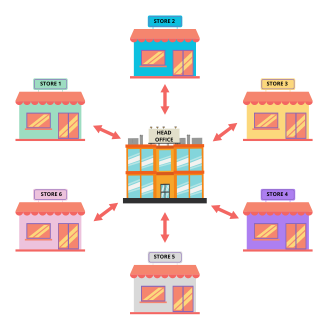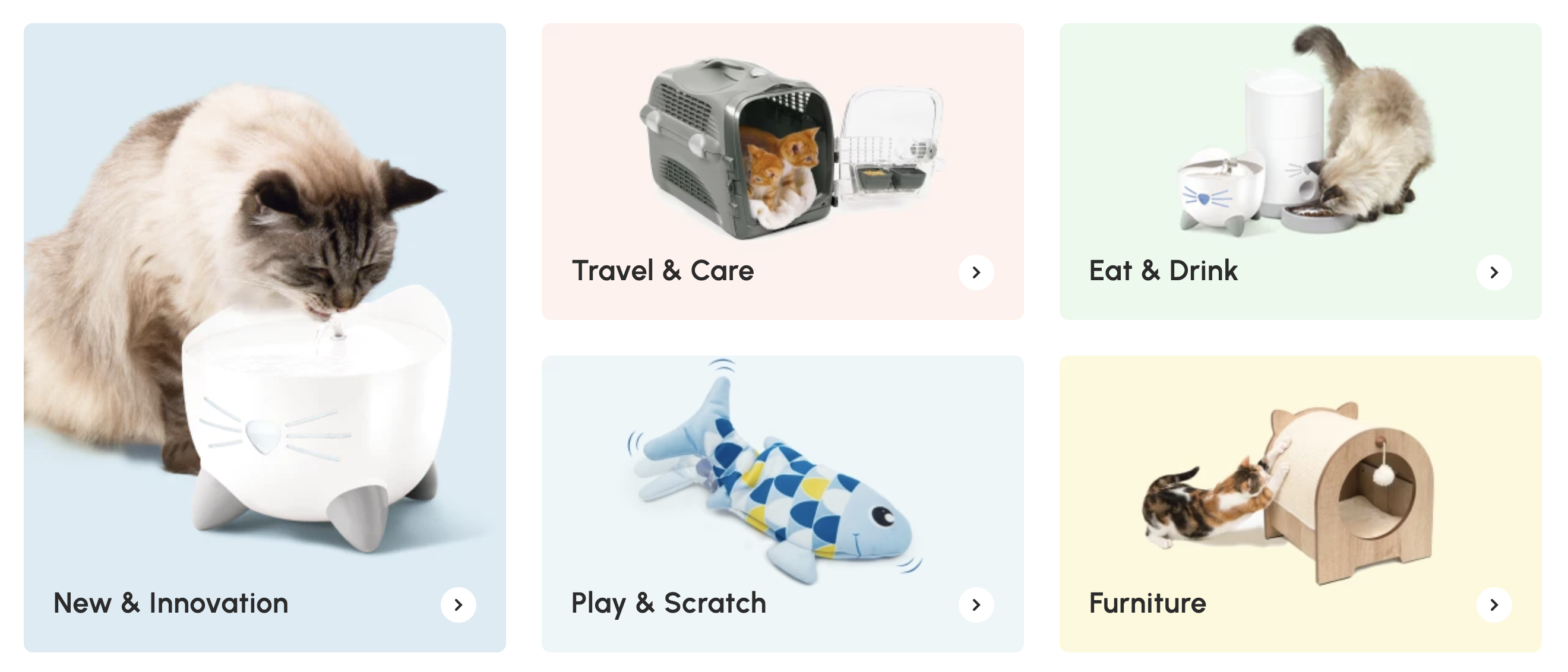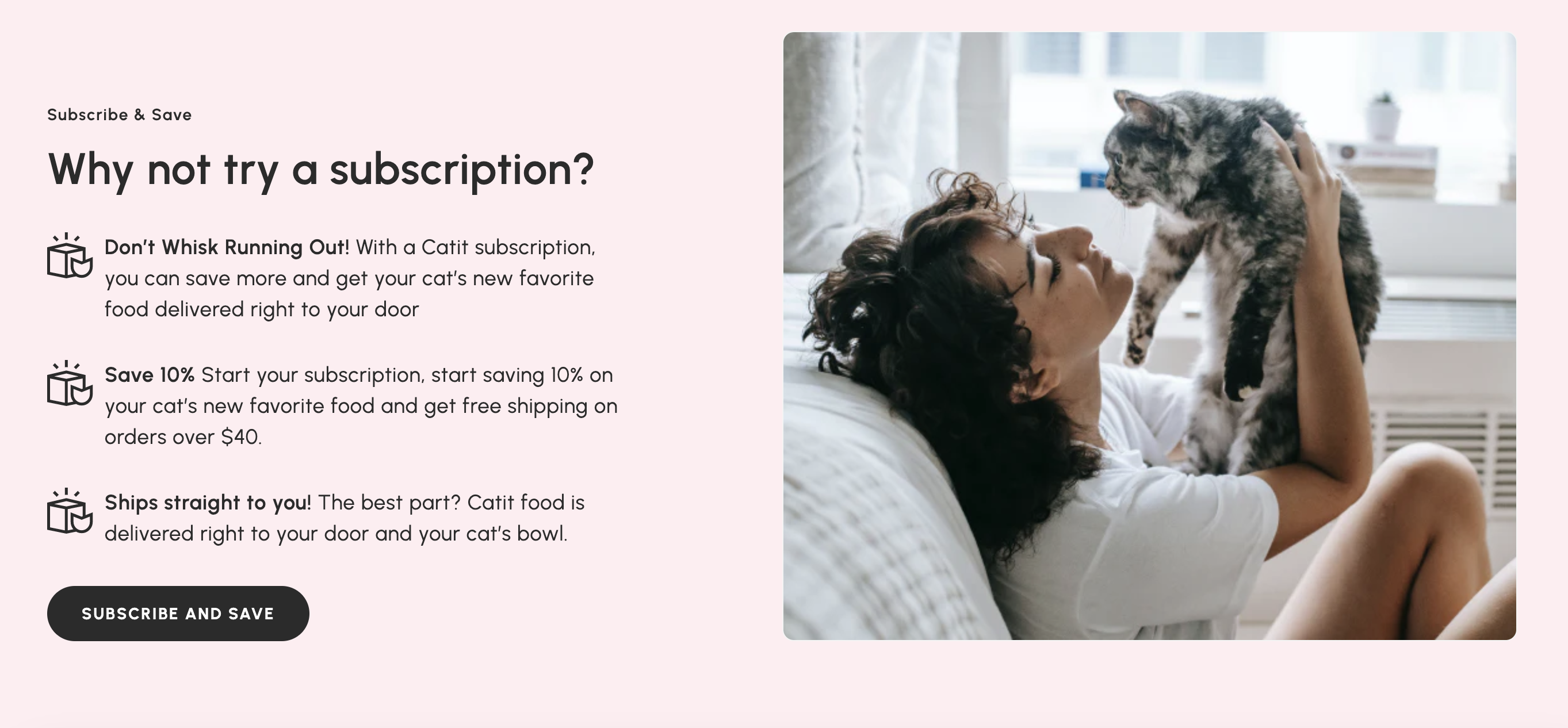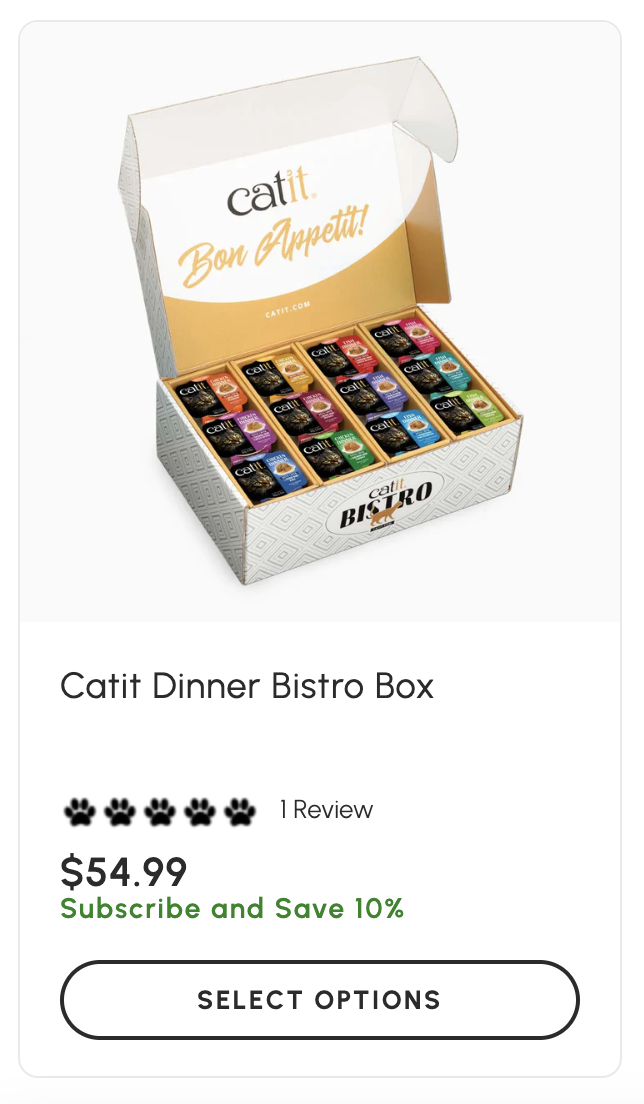Case Study: Migrating Catit’s Multiple International Online Stores From WooCommerce to Shopify Plus
This is the story of how we migrated international cat supplies brand Catit from WooCommerce to Shopify Plus. Find out how Swanky leveraged our expertise in ecommerce UX, bespoke Shopify development, internationalisation and subscription throughout this complex project.
Written By
Hannah Smiddy

TL;DR
- Swanky has been working with Catit’s regional teams across the globe to migrate six international ecommerce stores from WooCommerce to Shopify Plus.
- An innovative single codebase solution makes management of the six stores more efficient.
- Beyond replatforming, key aims of the project involved improving UX and navigation, and making subscription options more prominent across the US site.
- Catit’s Shopify Plus stores will be a key tool in the brand’s business armoury, driving growth across the globe.
Catit: Brand overview
Part of the Hagen Group (the largest privately owned pet speciality company in the world), Canadian cat brand Catit has been creating innovative, practical and convenient products for fussy felines across the globe since 1999. Its vast and premium product portfolio includes everything from treats and toys to furniture and feeders.
Catit currently trades in North America (with two separate ecommerce stores for the US and Canada) and across Europe (with individual websites serving the UK, France, Germany and Spain). Its products are also available via third party pet retailers in each of these markets.
Each Catit store is managed autonomously by a regional team, requiring the management of multiple stakeholders.
Project context: Multi-migration from WooCommerce to Shopify required
Catit approached Swanky looking to migrate their six international ecommerce stores from WooCommerce to Shopify Plus.
We often speak to online retailers who are frustrated by the WooCommerce platform and its frequent downtime, as well as its heavy reliance on plugins and extensions.
Typically, costs for things like hosting and security certificates can quickly mount up on WooCommerce – another issue that often spurs users to look for an alternative solution.
As one of the longest standing Shopify Plus agencies in the ecosystem, and with significant experience developing petcare ecommerce solutions, Swanky was well placed to handle Catit’s transition to Shopify.
How Swanky helped
1. Research & discovery
R&D is a critical part of any project at Swanky, with our findings from this phase underpinning our recommendations and decisions.
The R&D phase with Catit included:
- extensive discovery meetings with Catit’s six international teams;
- detailed analysis of Catit’s WooCommerce stores, identifying strengths of the current implementation and scoping out opportunities for new functionality;
- consideration of any tooling changes;
- development of ‘look and feel’ design concepts; and
- presentation of our recommendations.
This allowed us to identify clear opportunities to enhance Catit’s ecommerce performance, including:
- improving the user journey to find products (by improving site structure and navigation); and
- improving subscription and retention performance (by making subscription options more prominent and accessible).
We devised a strategic migration and launch plan which would tackle Catit’s US site first, followed by the UK store, with the four remaining stores following suit at planned intervals.
2. Migration from WooCommerce to Shopify
With Catit’s functional and business requirements guiding the project at every stage, we’ve been migrating the brand’s existing WooCommerce sites to Shopify Plus, creating six country-specific stores (you can read more about this international site structure in the next section).
For us, Shopify Plus represents the most scalable ecommerce platform on the market. Unlike WooCommerce, it is a comprehensive and reliable solution that’s specifically designed for ecommerce. It will give the Catit team the flexibility to make changes without having to rely on developers thanks to an intuitive user interface. Meanwhile, it boasts powerful native features, which, when combined with a rich network of apps and third party integrations, will unlock huge potential for innovation and growth.
The replatforming process involves careful extraction of product, order and customer data from WooCommerce via an API. This is then configured into a Shopify-ready format and imported into the new platform. For the transition of the US store, the process also involved migration of subscription data.
For information on the specific stages of a Swanky-led replatforming project, check out the breakdown of our tried and tested Shopify migration process.
3. International site structure: Multi-store management solution
For this project, we have taken a multi-store (or expansion store) approach, creating six separate Shopify stores that function independently of one another. This approach allows a brand to operate flexibly in different global markets, adhering to any region-specific requirements. It also offers an effective way to rank for keywords locally. We discuss further benefits of this model in our comparison of Shopify Markets vs expansion stores.
Whilst this multi-store structure can typically be complex to manage, with increased admin time and higher maintenance costs, our team of Shopify developers has created an innovative solution to reduce the complexity of managing multiple stores. With our solution, Catit’s six Shopify stores can be managed from a single codebase. Changes are automatically pushed from the master store to regional stores, which saves time and increases efficiency.

Read more about this unique multi-store management solution.
4. Improving navigation & UX
Having identified that Catit’s previous website navigation was not particularly user friendly, and that many visitors struggled to find the product they were looking for, we set about changing this.
Two-tier navigation
Firstly, we have introduced a two-step navigation to help narrow users’ attention and make it easier to select a relevant collection page to navigate to.
We worked with the client to define top-tier menu items, with language being more goal-oriented for this layer of the navigation. We then carried out a closed card sorting task in which we asked participants to sort a list of menu sub-items into categories that aligned with these top tiers. These suggestions were reviewed by the client before a new navigation was agreed upon.
Catit’s top-tier menu items are also reflected further down the homepage in clickable elements:

This needs-based navigation can provide an efficient route to purchase for shoppers, helping them efficiently navigate a vast range of products. It also increases awareness of the extent of Catit’s offering.
We talk more about the importance of needs-based navigation in our guide to selling pet products online.
Encouraging use of on-site search
As well as creating a more intuitive navigation, we have also increased visibility of the on-site search functionality, using prompts such as “What are you looking for?” to encourage use by high intent shoppers.

This would enable users to quickly find relevant products, with expedited access to suitable product pages.
5. Increasing subscription prominence
Having implemented new subscription functionality for a number of brands, including fellow petcare market leader YuMOVE, we were able to confidently consult on a subscription solution that would fit Catit’s needs for the US site.
In this case, we recommended the implementation of Recharge, allowing the store to launch with good UX and improved functionality. This popular solution will also be able to scale with the brand as it grows.
With the goal of increasing retention in mind, we shifted to an increased (but not dominating) subscription focus.
For example, the subscription user journey was made more accessible on the homepage and throughout the navigation. The snapshot below shows a section of the US store’s homepage which highlights the benefits of Catit’s ‘Subscribe & Save’ offering:

Furthermore, a dedicated subscription page clearly explains how a subscription with Catit works, as well as walking through the benefits for customers.
We also implemented subscription badges to be featured on collection page product tiles. These draw shoppers’ attention to the 10% cost saving.

Get advice from our Chief Creative Officer, Matt Giles, on how to improve the subscription journey on your site with his subscription UX design tips.
Summary
Upon completion of this multi-migration project, Catit will have a set of six Shopify Plus stores reliably powering DTC ecommerce sales and driving business growth across the globe. The brand’s regional teams can be confident in the platform’s ability to scale as the company attracts more customers, offers more products and drives more sales.
Migrate from WooCommerce to Shopify Plus with Swanky
At Swanky, we have years of experience migrating ecommerce websites from WooCommerce to Shopify. With our multidisciplinary team of project managers, technical specialists and digital strategists guiding the way, you can wave goodbye to your WooCommerce woes and accelerate your business growth on Shopify Plus, the ecommerce platform built for scale.
Get in touch with our Shopify Plus Experts today to find out how we can unlock your ecommerce potential with a migration from WooCommerce to Shopify.

